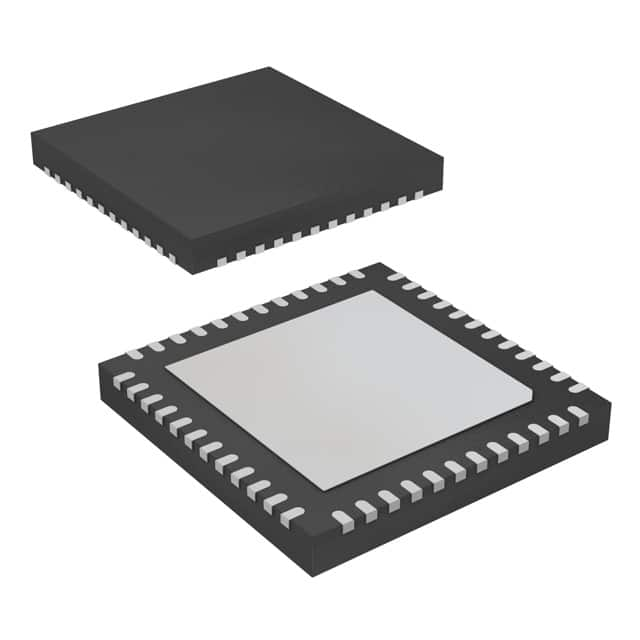ADS61B29IRGZR
Product Overview
Category
The ADS61B29IRGZR belongs to the category of analog-to-digital converters (ADCs).
Use
This product is used to convert analog signals into digital data for further processing or analysis.
Characteristics
- High-speed sampling rate
- Low power consumption
- Wide input voltage range
- High resolution
- Differential input configuration
Package
The ADS61B29IRGZR comes in a small form factor package, making it suitable for space-constrained applications.
Essence
The essence of the ADS61B29IRGZR lies in its ability to accurately and efficiently convert analog signals into digital format.
Packaging/Quantity
This product is typically packaged in reels or trays and is available in various quantities depending on customer requirements.
Specifications
- Resolution: 12 bits
- Sampling Rate: Up to 1 GSPS (Giga Samples Per Second)
- Input Voltage Range: ±2 V
- Power Supply: 3.3 V
- Operating Temperature Range: -40°C to +85°C
Detailed Pin Configuration
The ADS61B29IRGZR has the following pin configuration:
- VINP: Positive differential input
- VREFP: Positive reference voltage input
- VCM: Common-mode voltage output
- VREFN: Negative reference voltage input
- VINN: Negative differential input
- CLKP: Clock input positive
- CLKN: Clock input negative
- DGND: Digital ground
- DVDD: Digital power supply
- AVDD: Analog power supply
- D[0:11]: Digital output bits
- PDWN: Power-down control input
- RESET: Reset control input
Functional Features
- High-speed data conversion
- Low power consumption
- Differential input configuration for improved noise rejection
- Built-in reference voltage generation
- Power-down and reset control options
Advantages and Disadvantages
Advantages
- High-resolution conversion
- Wide input voltage range
- Low power consumption
- Compact package size
Disadvantages
- Limited resolution compared to higher-end ADCs
- Requires external clock source
Working Principles
The ADS61B29IRGZR operates on the principle of sampling and quantization. It samples the analog input signal at a high rate, converts each sample into a digital value, and outputs the digital data for further processing or analysis.
Detailed Application Field Plans
The ADS61B29IRGZR finds applications in various fields, including:
- Communications: Used in wireless communication systems for signal processing and modulation/demodulation.
- Test and Measurement: Enables accurate measurement and analysis of analog signals in test equipment.
- Industrial Automation: Used for data acquisition and control in industrial automation systems.
- Medical Imaging: Enables digitization of analog signals in medical imaging devices for diagnosis and analysis.
Detailed and Complete Alternative Models
- ADS62P49IRGCR: Higher-resolution ADC with 14-bit output and similar features.
- ADS54J60IRGCT: Dual-channel ADC with 16-bit resolution and higher sampling rate.
- ADS42JB69IRGC: Quad-channel ADC with 12-bit resolution and lower power consumption.
These alternative models offer different specifications and features to suit specific application requirements.
Word count: 411 words
قم بإدراج 10 أسئلة وإجابات شائعة تتعلق بتطبيق ADS61B29IRGZR في الحلول التقنية
Sure! Here are 10 common questions and answers related to the application of ADS61B29IRGZR in technical solutions:
Q: What is the ADS61B29IRGZR? A: The ADS61B29IRGZR is a high-speed analog-to-digital converter (ADC) designed for applications that require high-resolution digitization of analog signals.
Q: What is the maximum sampling rate of the ADS61B29IRGZR? A: The ADS61B29IRGZR has a maximum sampling rate of 250 Mega-samples per second (MSPS).
Q: What is the resolution of the ADC? A: The ADS61B29IRGZR has a resolution of 14 bits, allowing it to provide precise digital representations of analog signals.
Q: What is the input voltage range of the ADS61B29IRGZR? A: The ADS61B29IRGZR has a differential input voltage range of ±2 V, making it suitable for a wide range of signal levels.
Q: Can the ADS61B29IRGZR be used in low-power applications? A: Yes, the ADS61B29IRGZR features a power-down mode that reduces power consumption when the ADC is not actively converting signals.
Q: Does the ADS61B29IRGZR support multiple output interfaces? A: Yes, the ADS61B29IRGZR supports both parallel and serial output interfaces, providing flexibility in connecting to different systems.
Q: What is the typical noise performance of the ADS61B29IRGZR? A: The ADS61B29IRGZR has a typical signal-to-noise ratio (SNR) of 70 dB, ensuring accurate digitization of analog signals even in the presence of noise.
Q: Can the ADS61B29IRGZR be used in high-frequency applications? A: Yes, the ADS61B29IRGZR has a wide bandwidth of 500 MHz, making it suitable for high-frequency signal acquisition.
Q: Does the ADS61B29IRGZR have built-in digital filters? A: No, the ADS61B29IRGZR is a standalone ADC and does not include built-in digital filtering capabilities. External digital filters can be used if required.
Q: What are some typical applications of the ADS61B29IRGZR? A: The ADS61B29IRGZR is commonly used in applications such as wireless communication systems, radar systems, medical imaging, and test and measurement equipment where high-speed and high-resolution analog-to-digital conversion is required.
Please note that these answers are general and may vary depending on specific implementation requirements.


